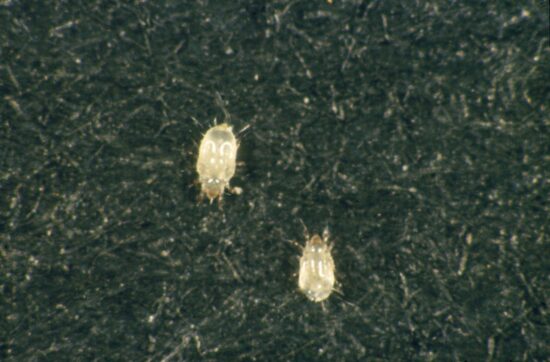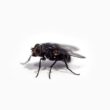Have you ever noticed tiny white bugs crawling around your home and wondered what they were? These little white bugs can be really annoying, especially when you don’t know what kind of pests you’re dealing with. The good news is that most of these tiny white bugs are more of a nuisance than a real threat to your family.
In this guide, you’ll learn how to identify the most common white bugs found in homes, where they like to hang out, and exactly how to get rid of them. We’ll also cover prevention tips to keep these unwanted visitors from coming back.
1. Dust Mites
What They Are: Dust mites are extremely small creatures that look like fine dust when they gather together. These tiny white bugs are so small that you can’t see them without a magnifying glass. They’re actually microscopic, but you can tell they’re there when you see dust building up around your home.
Where You’ll Find Them: Dust mites love warm, humid places where dead skin cells collect. You’ll find them in beds, couches, carpets, and even on electronics like game controllers and TV remotes. They especially like mattresses and pillows because that’s where people shed the most skin while sleeping.
How to Eliminate Them: The best way to control dust mites is to keep humidity levels low. Use a dehumidifier to keep humidity below 50%. Wash all bedding in hot water every week and cover your mattress and pillows with special dust-proof covers. When you dust, use a damp cloth instead of a dry one to avoid stirring up allergens in the air.
2. Springtails
What They Are: Springtails are small jumping bugs that can appear in large numbers when conditions are right. These little white bugs are about 1/16 inch long and can be white, gray, brown, or even greenish in color. They get their name because they have a special tail that works like a spring, helping them jump when they’re disturbed.
Where You’ll Find Them: These tiny white bugs love moisture, so you’ll usually spot them in bathrooms, kitchens, and laundry rooms. They often show up in sinks, bathtubs, and around leaky pipes. You might also find them in the soil of houseplants or in basements where it stays damp.
How to Eliminate Them: Since springtails need moisture to survive, the key is drying out their favorite spots. Fix any leaky pipes, use fans in bathrooms, and don’t overwater your houseplants. For quick results, spray the area with white vinegar and let it sit for 15 minutes before wiping it clean. You can also use a dehumidifier in damp areas to make the environment less welcoming for these pests.
3. Booklice (Psocids)
What They Are: Booklice aren’t actually lice at all, but they got this name because they’re often found near old books. These little white bugs are very tiny, usually between 1/25 and 1/13 of an inch long. They’re cream-colored or pale white and have soft bodies that make them hard to spot.
Where You’ll Find Them: Booklice feed on mold and mildew, so they love humid areas. You’ll find them in bathrooms, kitchens, and anywhere books or papers are stored in damp conditions. They also like to hang out under wallpaper, around windows, and in furniture where mold might grow.
How to Eliminate Them: These bugs can’t survive when humidity drops below 45-50%, so reducing moisture is your best bet. Use dehumidifiers or fans to dry out problem areas. Throw away any moldy books, papers, or other items where you see these pests. You can also sprinkle food-grade diatomaceous earth in areas where you spot them, which will help dry them out naturally.
4. White Mites
What They Are: White mites are actually a type of spider mite, which means they have eight legs like spiders. These tiny white bugs are incredibly small (about the size of a grain of salt) and have clear, white bodies. Even though they’re called white mites, they can sometimes look more transparent than truly white.
Where You’ll Find Them: White mites mainly live on plants, both indoors and outdoors. If you have houseplants, check them regularly for these pests. You’ll often see fine webbing on the leaves, which is a sure sign of a mite problem. They can also be found in greenhouses, gardens, and on outdoor plants.
How to Eliminate Them: For a natural solution, mix one teaspoon of rosemary oil with a quart of water and spray it on both sides of infected plant leaves. You can also use rubbing alcohol mixed with equal parts water. Spray this mixture on plants where you see webbing or suspect mites. Always test a small area first to make sure the treatment won’t harm your plants.
5. Grain Mites
What They Are: Grain mites are extremely small white bugs with a pearly appearance. These little white bugs love warm, humid conditions and can multiply very quickly. A female grain mite can lay up to 800 eggs in her lifetime, which is why infestations can get out of hand fast.
Where You’ll Find Them: As their name suggests, grain mites are usually found in the kitchen where dry goods are stored. They feed on flour, cereal, grains, cheese, and other pantry staples. These pests often come into your home already living in packaged food from the store. You might notice a brownish dust (called mite dust) on contaminated food.
How to Eliminate Them: Throw away all infested food products immediately and clean your pantry shelves thoroughly with hot, soapy water. Store all dry goods in airtight containers to prevent future infestations. Keep your pantry cool and dry, as grain mites need humidity to survive.
6. Whiteflies
What They Are: Whiteflies are small, soft-bodied insects that are about 1/16 inch long. They have a triangular shape and are usually gray-white in color. Despite their name, whiteflies aren’t actually flies but are more closely related to aphids. They have wings and can fly, which makes them easy to spot when they take off from plants.
Where You’ll Find Them: Whiteflies mainly live outdoors but can come into your home on infected houseplants. They like to hang out on the undersides of leaves, where they lay their tiny white eggs. If you have a lot of houseplants, check them regularly for these pests.
How to Eliminate Them: Start by gently spraying your plants with water to knock off the whiteflies and their eggs. You can also make a simple soap spray by mixing a squirt of dish soap with a gallon of water. Spray this on your plants in the evening when it’s cooler. Yellow sticky traps work great too because whiteflies are attracted to the color yellow.
7. Termites
What They Are: Termites are some of the most serious pests on this list. Worker termites are small, white bugs with soft bodies, bulging heads, and six legs. Soldier termites have white bodies but orange-brown heads with large jaws. These insects can cause thousands of dollars in damage to homes.
Where You’ll Find Them: Since termites live underground, you usually won’t see them unless there’s a serious infestation or they’re swarming. They attack wooden structures in homes and can do damage for years before anyone notices. Look for small holes in wood, piles of what looks like sawdust, or a hollow sound when you tap on wood.
How to Eliminate Them: Termites require immediate professional help. Don’t try to handle a termite problem on your own. The key to prevention is keeping moisture away from wooden structures and making sure wood doesn’t touch soil directly around your home. Have your home inspected by a professional every year to catch problems early.
8. Mealybugs
What They Are: Mealybugs are small, oval-shaped insects covered in a white, waxy coating that makes them look like tiny cotton balls. This waxy substance is how you can tell them apart from other tiny white bugs. They also produce a sticky substance called honeydew that can attract other pests.
Where You’ll Find Them: Mealybugs love plants, especially ones like fuchsias, gardenias, hibiscus, and citrus trees. While they’re more common outdoors, they can definitely make themselves at home on your houseplants. Look for them in groups on stems and under leaves.
How to Eliminate Them: Neem oil spray works well against mealybugs. Apply it once a week to control the infestation. You can also use insecticidal soap or simply remove heavily infested plants from your home. Always check new plants carefully before bringing them inside to avoid spreading mealybugs to your other plants.
9. Clothes Moths
What They Are: Clothes moths are small white or cream-colored moths with grayish-white wings. The adult moths are about 1/2 inch long, but it’s actually their larvae (tiny white caterpillars) that cause the most damage. These larvae love to eat natural fibers like wool, silk, and cashmere.
Where You’ll Find Them: These tiny white bugs are usually found in closets, storage areas, attics, and basements. They prefer dark, undisturbed places where clothes are stored for long periods. You’ll know you have a problem when you find small holes in your clothes, especially sweaters and other wool items.
How to Eliminate Them: Clean all affected clothes and vacuum closets thoroughly. Cedar blocks and mothballs can help repel these pests. Make sure storage areas have good ventilation, and consider using airtight containers for storing wool and other natural fiber clothing. Regular cleaning and inspection of stored clothes can prevent major problems.
10. Prevention Strategies
Moisture Control: Since most of these pests love humidity, controlling moisture is your best defense. Fix leaky pipes quickly, use exhaust fans in bathrooms, and wipe up any water condensation around windows. A dehumidifier can be a great investment for damp areas like basements and bathrooms.
Regular Cleaning: Keep your home clean by vacuuming regularly and dusting surfaces. Pay special attention to areas where food crumbs might collect, like under furniture cushions and around appliances. Store food in sealed containers and clean up spills right away.
Sealing Entry Points: Install screens on windows and doors, and make sure they fit properly. Use caulk to seal cracks around windows, doors, and in your foundation. This helps keep tiny white bugs from finding their way into your home in the first place.
Plant Inspection: Before bringing any new plants into your home, check them carefully for signs of pests. Look under leaves and around stems for bugs, eggs, or webbing. Keep new plants separate from your other plants for a few weeks to make sure they’re pest-free.
Environmental Management: Remove clutter from your home, as it provides hiding spots for pests. Keep firewood, compost piles, and other organic materials away from your house’s foundation. Trim bushes and trees so they don’t touch your house, which can provide a bridge for pests to get inside.
When to Call a Professional
Sometimes these little white bugs can be too much to handle on your own. Call a professional pest control service if you have large infestations that don’t respond to DIY treatments, if you see signs of structural damage (especially with termites), or if the bugs keep coming back no matter what you try.
Professional pest control experts know exactly how to identify different types of pests and can create a treatment plan that works for your specific situation. They also have access to stronger treatments that aren’t available to regular consumers.
Conclusion
Finding tiny white bugs in your home can be frustrating, but now you know exactly what you’re dealing with and how to handle each type of pest. Remember that prevention is always easier than treatment, so focus on keeping your home clean, dry, and well-sealed.
Most of these little white bugs are more annoying than dangerous, but it’s important to act quickly when you spot them. The sooner you identify and treat the problem, the easier it will be to get rid of these unwanted visitors for good.
If you’re ever unsure about what type of pest you’re dealing with or if your DIY treatments aren’t working, don’t hesitate to call in the professionals. They can help you get your home back to being comfortable and pest-free.


